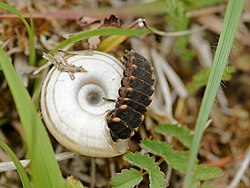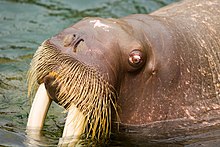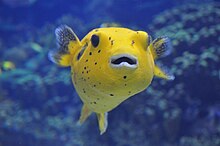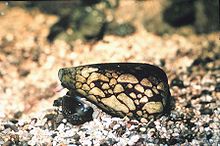Molluscivore
Amolluscivoreis acarnivorousanimal that specialises in feeding onmolluscssuch asgastropods,bivalves,brachiopodsandcephalopods.Known molluscivores include numerous predatory (and often cannibalistic) molluscs, (e.g.octopuses,murexes,decollate snailsandoyster drills), arthropods such ascrabsandfirefly larvae,and, vertebrates such asfish,birdsandmammals.[1]Molluscivory is performed in a variety ways with some animals highly adapted to this method of feeding behaviour. A similar behaviour,durophagy,describes the feeding of animals that consumehard-shelledorexoskeleton bearingorganisms, such ascorals,shelled molluscs, or crabs.[2]
Description[edit]
Molluscivory can be performed in several ways:
- In some cases, the mollusc prey are simply swallowed entire, including the shell, whereupon the prey is killed through suffocation and/or exposure to digestive enzymes. Only cannibalisticsea slugs,snail-eating cone shells of the taxonConinae,and somesea anemonesuse this method.
- One method, used especially by vertebrate molluscivores, is to break the shell, either by exerting force on the shell until it breaks, often by biting the shell, like withoyster crackers,mosasaurs,andplacodonts,or hammering at the shell, e.g.oystercatchersandcrabs,or by simply dashing the mollusc on a rock (e.g.song thrushes,gulls,andsea otters). It is hypothesized that human archaic ancestors such as early-PleistoceneHomo erectuson Java were predominantly molluscivorous: stone tool use, pachyosteosclerotic skeleton (slow+shallow diving), much larger brains (seafoods + DHA), fossilisations amid edible mussels (Pseudodon,Elongaria), island colonisations (e.g. Flores), early-Pleistocene intercontinental dispersal along coasts and rivers, enamel damage caused by "oral processing of marine mollusks" (Towle cs 2022 AJPA), ear exostoses (chronic cold-water irrigation), shell engravings (google "Joordens Munro" ), etc., google "gondwanatalks verhaegen".

- Another method is to remove the shell from the prey. Molluscs are attached to their shell by strong muscular ligaments, making the shell's removal difficult. Molluscivorous birds, such as oystercatchers and theEverglades snail kite,insert their elongate beak into the shell to sever these attachment ligaments, facilitating removal of the prey. The carnivorous terrestrial pulmonate snail known as the "decollate snail" ( "decollate" being a synonym for "decapitate" ) uses a similar method: it reaches into the opening of the prey's shell and bites through the muscles in the prey's neck, whereupon it immediately begins devouring the fleshy parts of its victim. Thewalrussucks meat out of bivalve molluscs by sealing its powerful lips to the organism and withdrawing its piston-like tongue rapidly into its mouth, creating a vacuum.
- Another method, used byoctopuses,nautiliiand most molluscivoruous sea snails, is to use theirradulato drill a hole through the shell, then inject venom and digestive enzymes through the hole, after which the digested prey can be sucked out through the hole.
- The larvae ofglowwormsandfirefliesare simply small enough to enter the shells of terrestrial snails and begin eating immediately.
In marine mammals[edit]

Whales:Sperm whales,pilot whales,Cuvier's beaked whale,Risso's dolphinand species in the generaMesoplodon,andHyperoodonand the superfamilyPhyseteroideaare classified as molluscivores, eating mainly squid.[3]
Pinnipeds:Elephant seals,Ross sealsandSouth American fur sealsare classed as molluscivores.[3]The walrus eats benthic bivalve molluscs, especiallyclams,for which it forages by grazing along the sea bottom, searching and identifying prey with its sensitivevibrissae.[4]The walrus sucks the meat out by sealing its powerful lips to the organism and withdrawing its piston-like tongue rapidly into its mouth, creating a vacuum. The walruspalateis uniquely vaulted, enabling effective suction.
In fish[edit]
Several species ofpufferfishandloachesare molluscivores. As many molluscs are protected by ashell,the feeding techniques applied amongst molluscivorefishare highly specialized and usually divided into two groups: "crushers" and "slurpers." Pufferfish tend to be crushers and will use theirbeak-like teeth to break the shell in order to gain access to the meat inside. Loaches are specialized slurpers, and will make use of their characteristically shapedsnoutin order to grab hold of, then suck out the animal living inside the shell.

Theblack carp(Mylopharyngodon piceus) commonly feeds by crushing large molluscs withpharyngeal teeth,extracting soft tissue, and spitting out shell fragments. Four-year-old juveniles are capable of consuming approximately 1–2 kg of molluscs per day. This bottom-dwelling molluscivore was purposely imported into the United States in the early 1970s for use as a food fish and also as a biological control agent for snails—an intermediate host for atrematodeparasite in fish reared on fish farms.[5]Two snail-eatingcichlids,Trematocranus placodonandMaravichromis anaphyrmis,have been tried as biological control agents ofschistosomesin fish ponds in Africa.[6]Redear sunfish(Lepomis micropholus) andbluegill(Lepomis macrochirus) have been used to controlquagga mussels(Dreissena bugensis) in the lower Colorado River in the US.[7]
The common name of some fish reflects their molluscivorous feeding, for example, the "snail-crusher hap" (Trematocranus placodon), "" red rock sheller "(Haplochromis sp.), "Rusinga oral sheller" (Haplochromis sp.) and "rainbow sheller" (Haplochromis sp.). The redear sunfish is also known as the "shellcracker".
In reptiles[edit]
Gray's monitor(or "butaan" ) is well known for its diet, which consists primarily of ripe fruit; however, several prey items are also consumed, including snails. [8]Monitors are generally carnivorous animals, which makes the Gray's monitor somewhat of an exception amongst the varanid family.
The prehistoricplacodontreptiles is an extinct taxon of marine animals that superficially resembled lizards and turtles, most of whose dentition of peg-like incisors and enormous, molar-like teeth allowed them to prey on molluscs and brachiopods by plucking their prey off of the substrate, and crushing the shells.[9][10]
In birds[edit]
Amongbirds,the eponymousshorebirdsknown asoystercatchersare renowned for feeding upon bivalves. At least onebird of preyis also primarily a molluscivore—thesnail kite,Rostrhamus sociabilis.Thelimpkinis a small rail-like bird that feeds almost entirely on apple snails. Other birds that will eat molluscs occasionally includemergansers,ducks,coots,dippersandspoonbills.[11]
In invertebrates[edit]


Cone snails:Some cone snails hunt and eat other kinds of snails, such as cowries, olive shells, turbo snails, and conch snails, while others will eat other cone snails.Conus marmoreusandConus omariaare able to kill and swallow prey that are larger than themselves; some Conus species can swallow prey that weigh up to half of their own weight. Snail's bodies are attached to their shell by a columellar muscle that holds onto thecolumella,the axis of the snail. This muscle also allows the snail to retract back into its shell. If this muscle is broken, the snail will lose its shell and die. It is hard to detach this muscle in a live snail, or even in a dead snail. It is thought that theconotoxinsin the venom of cone snails are able to completely relax this muscle so that the body can be pulled out from its shell. The cone snail uses its foot to hold the shell of its prey. Using a strong, steady pulling motion, the body of the snail can be forced out and then swallowed whole. Complete digestion of a snail can take many hours, even days.[12]
Starfish:Primitive starfish, such asAstropectenandLuidia,swallow their prey whole and start to digest it in their cardiac stomachs. Shell valves and other inedible materials are ejected through their mouths. The semi-digested fluid is passed into their pyloric stomachs and caeca where digestion continues and absorption occurs.[13]The margined sea star (Astropecten articulatus) is a well known molluscivore. It catches prey with its arms which it then takes to the mouth. The prey is then trapped by the long, moving prickles around the mouth cavity and swallowed food.
In more advanced species of starfish, the cardiac stomach can be everted from the organism's body to engulf and digest food. When the prey is a clam, the starfish pulls with its tube feet to separate the two valves slightly, and inserts a small section of its stomach, which releases enzymes to digest the prey. The stomach and the partially digested prey are later retracted into the disc. Here the food is passed on to the pyloric stomach, which always remains inside the disc.[14]Because of this ability to digest food outside the body, starfish can hunt prey much larger than their mouths.
Crabs:Thefreshwater crabsSyntripsa matannensisandSyntripsa flavichelaare classed as molluscivores.[15]Using their massive and powerful claws, adultFlorida stone crabs(Menippe mercenaria) feed onacorn barnacles,hard-shelled clams,scallops,andconch.[16]
References[edit]
- ^"Molluscivore".Palaeos.RetrievedJune 5,2013.
- ^Huber, D.R., Dean, M.N. and Summers, A.P., (2008), Hard prey, soft jaws and the ontogeny of feeding mechanics in the spotted ratfishHydrolagus colliei.Journal of the Royal Society Interface( online publishing)[1][permanent dead link]
- ^abJarman, P.J, Lww, A.K. and Hall, L.S."Fauna of Australia:Natural History of the Eutheria"(PDF).Archived fromthe original(PDF)on 2012-03-21.RetrievedJune 8,2013.
{{cite web}}:CS1 maint: multiple names: authors list (link) - ^Levermann, N., Galatius, A., Ehlme, G., Rysgaard, S. and Born, E.W. (2003)."Feeding behaviour of free-ranging walruses with notes on apparent dextrality of flipper use".BMC Ecology.3(9): 9.doi:10.1186/1472-6785-3-9.PMC270045.PMID14572316.
{{cite journal}}:CS1 maint: multiple names: authors list (link) - ^Crosier, D.M., Molloy, D.P. and Rasmussen, J."Black CarpMylopharyngodon piceus"(PDF).Archived fromthe original(PDF)on 2013-02-17.RetrievedJune 8,2013.
{{cite web}}:CS1 maint: multiple names: authors list (link) - ^Chiotha, S.S., McKaye, K.R, Stauffer, J.R., (1991). Use of indigenous fishes to control schistosome snail vectors in Malaŵi, Africa. Biological Control, 1: 316–319
- ^Karp, K."Summary of Laboratory Experiments to Evaluate Consumption of Juvenile/Adult Quagga Mussel by Redear Sunfish and Bluegill".RetrievedJune 8,2013.
- ^"The Butaan Project - Background and History".RetrievedJune 8,2013.
- ^Rieppel, O. (2002). Feeding mechanisms in Triassic stem-group sauropterygians: the anatomy of a successful invasion of Mesozoic seas Zoological Journal of the Linnean Society, 135, 33-63
- ^Naish, D. 2004. Fossils explained 48. Placodonts. Geology Today 20 (4), 153-158.
- ^Mayntz, M."Molluscivorous".Archived fromthe originalon May 15, 2013.RetrievedJune 7,2013.
- ^Chadwick, A. (2013)."The cone snail".RetrievedJune 7,2013.
- ^Ruppert, E.E., Fox, R.S. and Barnes, R.D., (2004).Invertebrate Zoology,7th edition. Cengage Learning.ISBN81-315-0104-3
- ^Dale, Jonathan (2000)."Starfish Digestion and Circulation".Madreporite Nexus.RetrievedJune 7,2013.
- ^Schubart, C.D., Santl, T. and Koller, P., (2008). Mitochondrial patterns of intra- and interspecific differentiation among endemic freshwater crabs of ancient lakes in Sulawesi. Contributions to Zoology, 77: 83-90[2]
- ^Williams, A., (1984).Shrimps, lobsters, and crabs of the Atlantic coast of the Eastern United States, Maine to Florida.Washington, D. C.: Smithsonian Institution.

